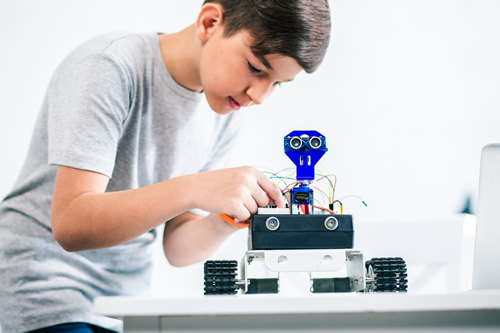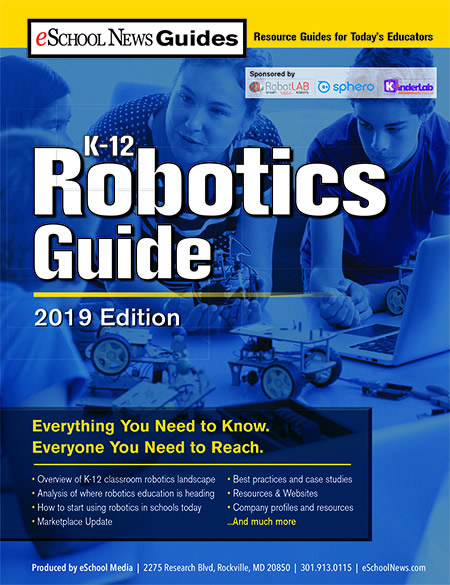Rural schools in the United States face challenges many of their suburban counterparts couldn’t fathom. For example, access to challenging and engaging STEM courses such as robotics and coding is not as prevalent in rural schools as it is in larger districts. But one district is aiming to make it easier for students to access robotics in rural schools.
“Out of the Loop,” a 2018 report from The National School Boards Association Center for Public Education, notes that “rural students have significantly less access to STEM-focused AP courses” and that gaps such as this “may indicate that rural students have limited access to academically rigorous programs.”
Related Content:
eSchool News Robotics Guide
The eSchool News Robotics Guide is here! It features strategies to help you effectively integrate robotics into instruction, along with tips to find the right robotics resources to successfully teach key concepts. A new eSchool News Guide will launch each month–don’t miss a single one!
One rural district in North Dakota is fighting this statistic with a K-12 STEAM program that prepares students for the future by teaching 21st-century skills necessary in today’s–and tomorrow’s–workforce.
Alexander, North Dakota, epitomizes small-town America. A 2017 estimate puts the population at 308, and the Alexander Public School serves around 260 K-12 students. Seeing a need to instill future workforce skills in their students, the district implemented their K-12 STEAM program, which includes coding and robotics, about five years ago. Superintendent Leslie Bieber attended a conference and had the opportunity to learn to program robots. When she returned, she worked with former robotics team coach Alexandria Brummond, who at the time was the school’s second-grade teacher. “The program developed over the years,” says Bieber, eventually including a TETRIX class, which then became a FIRST Tech Challenge class and team.
“STEAM and robotics are the future of our world,” said Bieber. “We are preparing our students for jobs that we don’t even know will exist in the near future.”
TETRIX: Tools for the trade
An integral part of the district’s STEAM program is the FIRST Tech Challenge class (formerly a TETRIX class) for sophomores through seniors. “When the class was created, we wanted to give students an opportunity to pursue another CTE credit through a 21st-century skill-based, hands-on program that incorporates the FIRST philosophy,” says Brummond, who is now the school’s pre-K-12 STEM and robotics teacher. Students in the class use TETRIX robotics sets and form a team to compete in the FIRST Tech Challenge each year. The class currently has six students, all of whom are on the team.
What the district lacks in number of students, they more than make up for in enthusiasm, especially when it comes to competing against larger districts in robotics competitions. In their four years of competing, the Alexander Comets have received Rookie Team of the Year, Second-Place Alliance, Fourth-Place Alliance, and Design awards. Additionally, they have shared their robot design with the governor of North Dakota as well as with state legislators and area teachers, students, and community and business members.
Related content: 3 things to consider when introducing a K-12 coding or robotics program
“We have wonderful community support,” says Bieber. “Two years ago, we started an annual showcase of our technology programs and invited our stakeholders and businesses to the event. We have also gone to the state capital for the last three years with all grade levels to showcase our robotics programs to our state government.”
PRIME (and MAX) lessons
In addition to the TETRIX FIRST Tech Challenge Competition Set, Alexander’s high school students also work with TETRIX PRIME, which Brummond says they went with “because of the ease of use.” PRIME sets come with everything needed for students to hit the ground running and are designed to enable students to assemble and disassemble robots quickly within a class period.
After students master PRIME, learning to build and code with TETRIX MAX comes easily. After that, they begin building the skills they need to become a strong FIRST team.
Taking robotics in rural schools and bridging to the real world
Learning robotics and coding has given Alexander students critical-thinking and problem-solving, communication and collaboration, and creativity skills they can use in the real world.
“When a part on the robot doesn’t work, being able to quickly work together to brainstorm, design, build, and test a new part is all part of the critical thinking and collaboration that is done in the [FIRST] program,” says Brummond.
It’s also a big part of how things are done in today’s workforce. Employers look for workers who can quickly jump into any given situation and help solve a problem, which is exactly what robotics teaches. A well-designed robotics and coding continuum such as the one in Alexander doesn’t just put robotics in rural schools–it connects students to real-world applications through hands-on activities and challenges, immersing them in a variety of STEM subjects. When students measure, choose gear and motor sizes, connect wires, write code, and work with others to troubleshoot and solve issues, they see their classroom lessons on fractions and ratios, electricity, engineering design, and even spelling and language arts used in practical applications.
Bieber is already seeing this connection. “A few of my elementary teachers have begun to integrate coding into other subjects,” she says. “The entire concept of STEAM education is now cross-curricular.”
The future looks bright
As we prepare students for a labor market where the skills required are not well-defined and a world where technology advances at a pace faster than anyone can keep up with, we must ensure that the knowledge children develop in school is flexible.
Alexander’s K-12 STEAM program is doing just that, creating lifelong learners ready to tackle whatever challenge comes their way. “Our program continues to grow,” says Bieber. A sure sign that where there’s a will to prepare students for jobs of the future – even in rural school districts – there’s a way.
- Building ethical AI usage in K-12 education - December 23, 2024
- Science teachers, math teachers, history teachers–we’re all reading teachers now - December 20, 2024
- Using AI to teach persuasive writing to English learners - December 20, 2024



